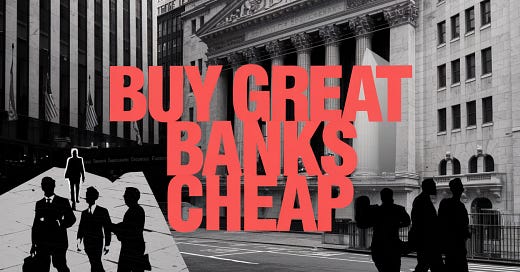At first glance, U.S. banks look absurdly cheap, trading around 10 times earnings.
Yet they're still getting hammered as investors price in recession fears.
But let me show you how to capitalize on this panic by selling cash-secured puts on high-quality banks, effectively buying great stocks at even deeper discounts (or pocketing premium income while everyone else panics).
A Quick Snapshot
Valuations & Dividends: Most large banks hover around 9–10x forward earnings, with yields near 3%. OZK is even cheaper at ~7x.
Capital Strength: Post-2008 regulations mean CET1 ratios (in the low teens for the biggest players) remain robust.
Consumer Exposure: Heavier consumer loan books (40–45% at BAC and Citi) could face more risk. Meanwhile, regional banks like USB, PNC, and OZK keep that figure closer to 20–30%.
So if the fundamentals look good, why are they languishing?
Because the market’s fixated on whether the economy slides into a downturn—especially as tariff threats, inflation, and new government “efficiency” measures threaten to slow growth.
Enter the Recession Fears
Tariffs & Austerity: President Trump’s renewed trade threats have led to retaliatory measures from key trading partners, and the Department of Government Efficiency (DOGE) is aiming for massive budget cuts.
Together, these factors can suppress consumer and business spending, fueling recessionary dread.
Weakening Consumer Signals: Rising rates, sticky inflation, and decreased mobility from locked-in mortgage holders crimp household finances—and thus bank loan growth.
GDPNow Volatility: The Atlanta Fed’s nowcast swung sharply negative due to net export concerns. While it may be an overreaction, the jitters remain.
So Where’s the Opportunity?
Despite a generally gloomy backdrop, these banks sport low valuations, healthy balance sheets, and ample capital to withstand a slowdown.
And that sets the stage for a contrarian tactic: selling cash-secured puts on high-quality banks to potentially buy them at even cheaper valuations—or keep the option premium if the stock price never hits your strike.
What Is a Cash-Secured Put?
It’s an option strategy where you sell (i.e., write) a put contract on a stock you’re willing to own at a certain strike price.
You must have the cash in your account to cover the purchase if the option is exercised.
If the stock stays above the strike, the option expires worthless and you pocket the premium.
If the stock dips below the strike, you buy the shares at that (lower) price—effectively scoring a “discounted” entry, plus you keep the original premium.
Why This Strategy Now?
Market Volatility = Juicier Premiums
When fear is high, implied volatility spikes—and so do option prices. By selling puts in a jittery market, you earn a richer premium for taking on the conditional risk of buying shares at the strike.Potential to Own Quality Banks at a Bargain
If your put gets exercised, you’re buying a stock like Bank OZK at an even cheaper multiple—say 6 or 7 times earnings—plus you still keep the premium.Aligned With Recession Fears
If a recession hits and bank shares plummet, you acquire them at a strike price you’ve deemed fair or undervalued. If the recession doesn’t materialize (or the stock holds up anyway), you simply pocket the option premium as income.
Two Concrete Examples
🟢 Example 1: Bank OZK (OZK)
Current Valuation: ~7x earnings, modest consumer exposure (~20%), a track record of strong capitalization.
The Trade: I sold OZK May 16 $40 puts for $1.35.
If Exercised: Cost basis becomes $38.65 (strike minus the premium), equating to a ~6.6x earnings multiple and a dividend yield over 4%.
If Unexercised: The puts expire worthless, and I keep the entire premium—yielding roughly 18% annualized.
🟢Example 2: U.S. Bancorp (USB)
Current Valuation: ~9x earnings, CET1 ~12%, well-diversified loan book.
The Trade: I sold puts at a strike slightly below current market.
If Exercised: I buy USB shares at a discount and hold a stable, regionally focused bank.
If Unexercised: The premium remains mine, an added boost to my liquidity or income stream.
Managing Risk: Don’t Put All Your Eggs in One Basket
Diversify: Even top-tier banks can suffer during a severe downturn. Spread your capital across different names or even different sectors.
Stress-Test: Model out a recession scenario—rising defaults, compressed net interest margins, etc. That ensures you’re comfortable taking ownership if the economy slides.
Keep Liquidity: Volatile markets can present new opportunities (or new hazards). Retaining some cash cushion means you can pivot if conditions worsen.
The key message here is that bank stocks, despite being sold off alongside growth names, aren’t hopeless.
In fact, they could be a sweet spot if you think the market’s gone overboard with recession fears.
By selling cash-secured puts on these undervalued yet fundamentally sound banks, disciplined investors can aim for two outcomes:
Acquire shares at a lower, more attractive price if markets remain skittish and the stock dips below your strike.
Collect healthy premiums if share prices stay above the strike—earning you extra income while you wait for calmer economic waters.
Either way, you get paid for your patience—and potentially set yourself up to own resilient, dividend-paying financial stocks at bargain valuations.
Thanks for reading!
Mike Thornton, Ph.D.
Proud Father of Two,
and Die-Hard Believer in Doing Good While Growing Wealth





